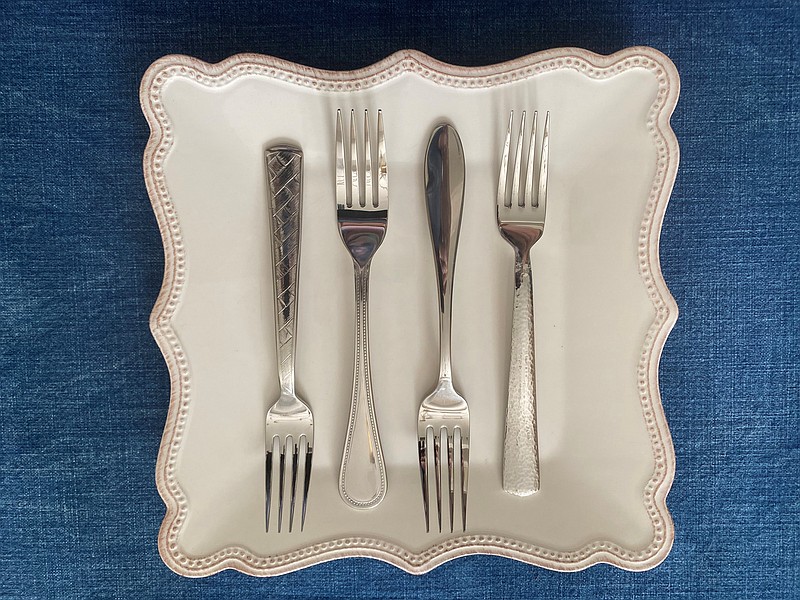Here's why I will never become rich as a home design columnist. Because, far too often, when I go out to investigate some aspect of better living, I wind up buying into it. Literally.
Which brings me to my new flatware.
Upon learning that 30 years of sack lunches and summer picnics had decimated my silverware drawer to the point where I was down to five forks from the original 16, I found myself in the flatware market. That's when it struck me like a meat cleaver in the forehead that although I had written columns about many common categories of kitchenware — pots and pans, wineglasses, kitchen knives, table linens — I had never talked about our everyday flatware.
"Apart from what you may have filched from the college cafeteria, (who me?), flatware is one of those purchases you typically only make twice in your life," said Greg Owens, co-owner of Sherrill Manufacturing, which makes Liberty Tabletop flatware, the only flatware still made in America.
"You buy once when you leave the dorm for your first real apartment," he said. "You go to Walmart and get a 40-piece place setting for $29.95. You buy again, maybe, when you grow up and settle down."
I guess I'm finally grown up.
Owens' typical customer is a female over 40 who cares about setting a nice table. Not surprisingly, genders approach the decision differently, he added. "When men judge flatware, they pick up the knife to feel how heavy it is. Women look at the details of the dinner fork."
After my conversation with Owens, I decide to try out his company's sample program. I open my laptop to the flatware page, which features 33 patterns. I loop in my husband, who, inconveniently, has opinions on such matters. He picks two patterns, and I picked two. A few days later the samples arrive, and the fork-to-fork competition — a lengthy, deeply analytical discussion — begins.
At one point, each pattern was in the lead, but, as in a close horse race, the front runner would drop back, to be overtaken by the horse in third place. In the end, my husband liked one set that had a woven texture. I liked another, that was mirror shiny and sleek. The two contenders faced off over dinner. The discussion continued. These are big stakes, people! In the end, he deferred.
In addition to the flatware basics we covered in last week's column (material, style, size, and finish), here's what else to consider when buying this household staple:
◼️ Feel. When selecting the silverware you will hold every day, pay attention to how it feels in your hand. Pick up a piece and get a sense of its balance, weight and contours. Contours should feel pleasant to hold. Heft is also important. You don't want your flatware to feel like the flimsy stuff found in school cafeterias. "It should pass the ice cream test," Owens said. "You should be able to scoop hard ice cream without bending the spoon."
◼️ Compatibility. Your flatware should get along with your dishware. We set each sample pattern alongside our nice dishes and our everyday dishes to see how the combination worked. Some patterns fought while others harmonized. Usually, if your dishes are simple, your silverware can be more ornate, though plain also works. Mixing patterns is tricky. Trust your eye.
◼️ Wearability. Mirror and satin finishes will show wear sooner than ornate finishes, but that's all part of the patina. "Ornament on handles will almost always hide scratches and dings, so tend to hold onto their newness longer," Owens said. Regardless, proper handling is important. "Don't dump your flatware in a sink with 100 other pieces banging around ...."
◼️ Practicality. DC and I eliminated my original favorite pattern because the base of the utensils was too wide to fit in the slots of our dishwasher's silverware basket.
◼️ Hollow or solid? The world of flatware has two types of knife handles. Hollow-handled knives, where two halves of the handle come together around the tang of the blade. The halves are soldered together and the hollow is filled with epoxy or cement. In solid-handle knife construction, knives are forged out of one solid piece of steel. Solid-handled knives are stronger, but hollow-handled knives are more balanced, so less likely to fall off the edge of a plate.
We ordered a 65-piece place setting of the Betsy Ross pattern, which is modern yet classic, with solid knife handles, to make DC happy, and extra serving pieces, providing yet another example of how my pursuit of better living comes at a price.
Marni Jameson is the author of six home and lifestyle books, including "What to Do With Everything You Own to Leave the Legacy You Want."
